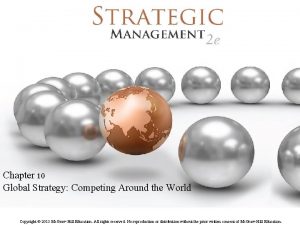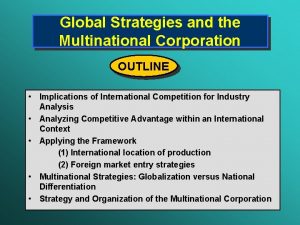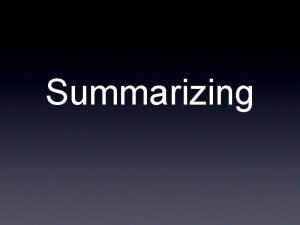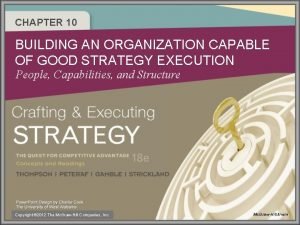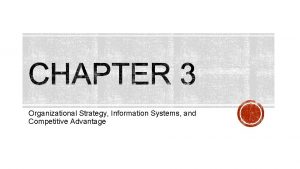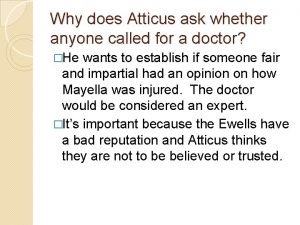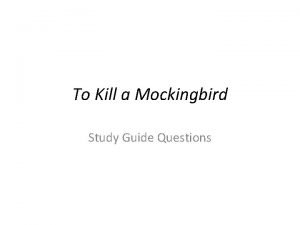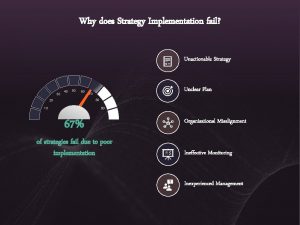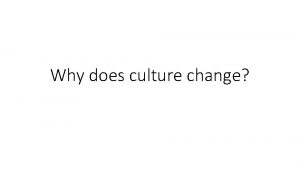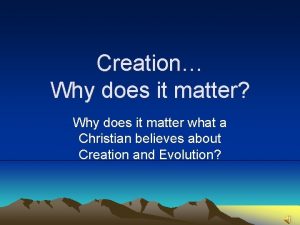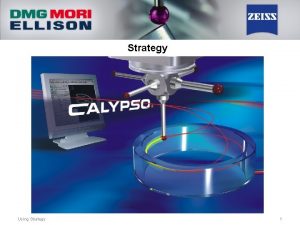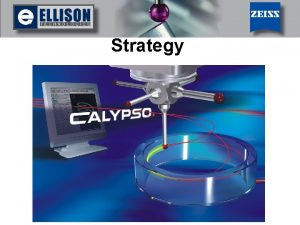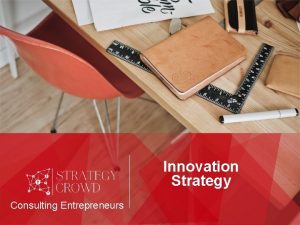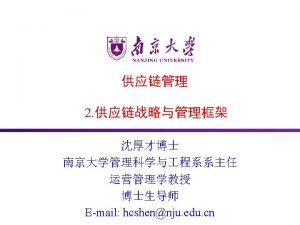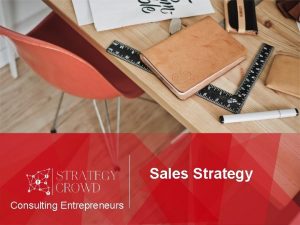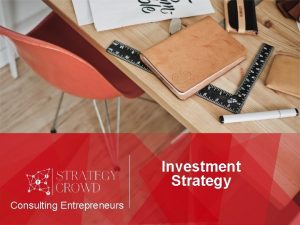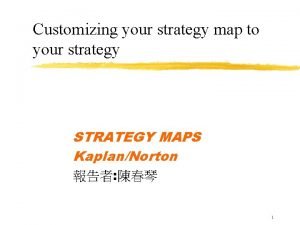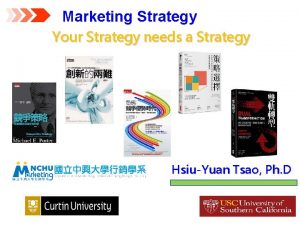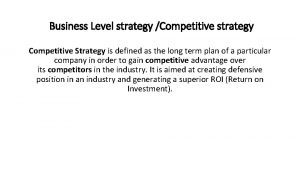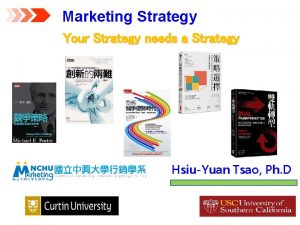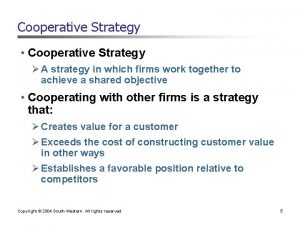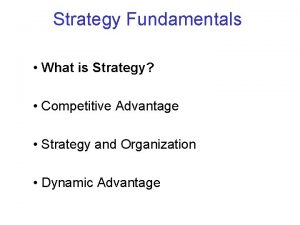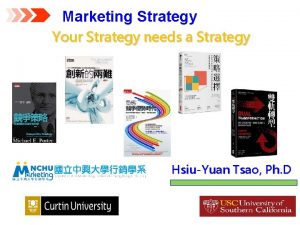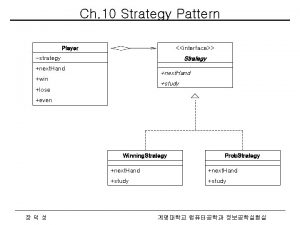Chapter 1 What is Strategy Why Does It






























- Slides: 30

Chapter 1 What is Strategy? Why Does It Matter? 2 -

What Is Strategy? Strategy involves … Time - the present, the future, and the track between Choices – products, markets, services, …. Resources – money, people, tools, etc. Competencies – what we are good at Something that is VRI-O Much more! 1 -2

What Is Strategy? Strategy is … The combination of competitive moves and business approaches used by managers to run the company Management’s theory about how to gain competitive advantage – BTW, what’s a theory? A comprehensive plan stating how the firm will achieve its mission and objectives 1 -3

What Is Strategy? Strategy is … Management’s “game plan” or, its HOW TO • Attract and please customers • Stake out a market position • Compete successfully • Grow the business • Achieve targeted objectives 1 -4

What Is Strategy? Strategy is … The General’s view (Strategos) Integrated Externally oriented Cyclical: Conceptual … Planned … Executed … Reviewed 1 -5

Walt Disney Company 1984 Profits: $242 Million Theme Park Operations: 77 percent of profits Consumer Products: 22 percent of profits Filmed Entertainment: 1 percent of profits 1 -6

Walt Disney Company Hired Michael Eisner - 1984 1. Increased admission prices at theme parks 1984 - $186 m 1989 - $787 m 2. Focused on movie studios (character development) 1984 - $2. 42 m 1994 - $845 m 3. Diversified into television (ABC), hotels, retail stores, sport team, cruise line, publishing, consumer products, licensing, etc. (Huey & Mc. Gowan, 1995) Market Cap: 1984 = $2 billion 1994 = $28 billion 1 -7

Inferring Strategy A company’s strategy is reflected in what it does and says (see p. 6 of your text) What do you think Eisner’s strategy was? Eisner’s basic theory (strategy) may have been: People will pay a premium price for extraordinary entertainment. We have the necessary resources to create extraordinary entertainment. Therefore, let’s redeploy our resources in a different way and offer something extraordinary to people. 1 -8

So Why is Strategy Important? Strategy + Execution = ? Management ! It is management’s job to get results 1 -9

Summary Strategy is about creating a desirable future, and it is important because that future is desired. 1 -10

But remember … The future is foggy! 1 -11

Recommended reading: 1 -12

Chapter 2 The Managerial Process of Crafting and Executing Strategy 1 -13

The Strategic Management Process External Analysis Mission Strategic Choice Objectives Strategy Implementation Competitive Advantage Internal Analysis 1 -14

The Strategic Management Process External Analysis Strategic Choice Objectives Strategy Implementation Competitive Advantage Internal Analysis Mission 1 -15

The Strategic Management Process Objectives: • specific, measurable targets, etc. (SMART) • the things a firm needs to ‘do’ to achieve its mission • should influence other elements in the strategic management process See text p. 28 for examples 1 -16

The Strategic Management Process External and Internal Analysis Systematic Examination of the Environment External Analysis • interest rates • demographics Internal Analysis • human resources (knowledge) • social trends • manufacturing abilities • technology 1 -17

The Strategic Management Process Strategic Choice Internal Analysis External Analysis Strategic Choice Business Level • positioning a business Corporate Level • which businesses? 1 -18

The Strategic Management Process Strategy Implementation • how strategies are carried out • who will do what • organizational structure and control • who reports to whom • how does the firm hire, promote, pay, etc. 1 -19

The Strategic Management Process Strategy Implementation • every strategic choice has strategy implementation implications • strategy implementation is just as important as strategy formulation (or maybe more so – my view) A Strategy Is Only As Good As Its Implementation 1 -20

The Strategic Management Process Competitive Advantage Definition: the ability to create more economic value than competitors External Analysis Mission Objectives Internal Analysis Strategic Choice Strategy Implementation Competitive Advantage • all other elements of the strategic management process are aimed at achieving competitive advantage 1 -21

Competitive Advantage The Ability to Create More Economic Value Than Competitors • there must be something different about a firm’s offering vis-à-vis competitors’ offerings • if all firms’ strategies were the same, no firm would have a competitive advantage • competitive advantage is the result of doing something different and/or better than competitors 1 -22

Competitive Advantage Two Types of Difference 1) Preference for the firm’s output • people choose the firm’s output over others’ • people are willing to pay a premium Example: Nordstrom 2) Cost advantage vis-à-vis competitors • lower costs of production/distribution Example: Wal-Mart 1 -23

Competitive Advantage The Strategic Management Process External Analysis Internal Analysis Strategic Choice Strategy Competitive Implementation Advantage • identify and exploit differences that may lead to competitive advantage Example: Apple’s i. Pod 1 -24

Competitive Advantage Temporary & Sustainable • competitive advantage typically results in high profits • profits attract competition • competition limits the duration of competitive advantage in most cases Therefore, • most competitive advantage is temporary • competitors imitate the advantage or offer something better 1 -25

Competitive Advantage Measuring Competitive Advantage Superior Economic Performance Is Viewed as Evidence of Competitive Advantage • it is rather easy to see the evidence of competitive advantage • measuring the source of the advantage per se is typically impossible • it’s difficult to ‘measure’ technology 1 -26

Competitive Advantage & The Strategic Management Process Emergent vs. Intended Strategies • the strategic management process leads managers to intended strategies However, • conditions often change or new information becomes available • managers respond adopt emergent strategies 1 -27

The Strategic Management Process Summary This course is not about mere survival, it is about thriving—achieving competitive advantage • the strategic management process helps managers achieve competitive advantage • competitive advantage depends on differences • strategy is about discovering and exploiting these differences 1 -28

The Strategic Management Process Applying Strategy to Your Career • a solid understanding of strategy concepts will help set you apart from other job candidates • you can use the process to identify and exploit difference between you and others • you can use the process to determine if you want to stay with a company 1 -29

The Strategic Management Process & Competitive Advantage Strategy Matters! Strategy is often the difference between: • success and failure, between mediocrity and excellence • a great manager and average managers • stumbling through life and moving ahead with purpose 1 -30
 Hey hey bye bye
Hey hey bye bye Don't ask why why why
Don't ask why why why Does the table represent a function why or why not
Does the table represent a function why or why not What does the image represent
What does the image represent What is maycombs usual disease
What is maycombs usual disease Business strategy vs corporate strategy
Business strategy vs corporate strategy Home replication strategy example
Home replication strategy example Chase strategy aggregate planning example
Chase strategy aggregate planning example Transnational strategy example
Transnational strategy example Aligning hr strategy with business strategy
Aligning hr strategy with business strategy Porter’s diamond of national advantage
Porter’s diamond of national advantage Managerial process of crafting and executing strategy
Managerial process of crafting and executing strategy Globalization strategy
Globalization strategy Listening
Listening Strategic management chapter 7
Strategic management chapter 7 International or multinational
International or multinational Summarizing definition in reading
Summarizing definition in reading From where does kat recognize the girl with red hair
From where does kat recognize the girl with red hair Recruiting and retaining capable employees do not entail
Recruiting and retaining capable employees do not entail How does organizational strategy determine is requirements
How does organizational strategy determine is requirements Why-why analysis
Why-why analysis Why do you cry willie why do you cry
Why do you cry willie why do you cry Why or why not
Why or why not Pengertian root cause analysis
Pengertian root cause analysis The swift horizontal movement of air is called
The swift horizontal movement of air is called Why ice sticks to skin
Why ice sticks to skin Why does atticus unbutton his vest
Why does atticus unbutton his vest Why does the coin jump
Why does the coin jump Marigolds plot diagram
Marigolds plot diagram Why do maycomb officials bend the rules for the ewells
Why do maycomb officials bend the rules for the ewells Who is blamed for trespassing on the radley place
Who is blamed for trespassing on the radley place










